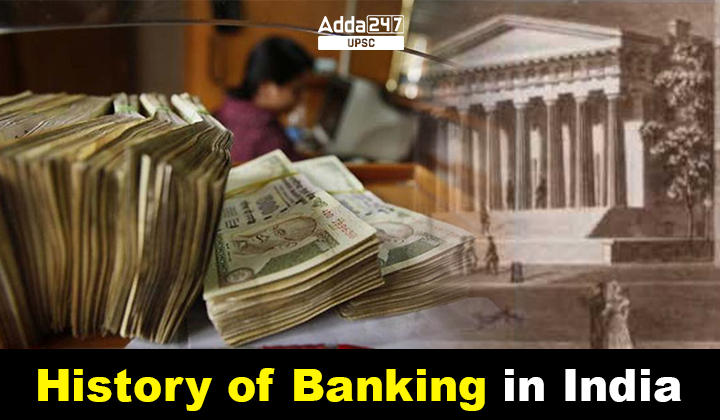Table of Contents
History of Banking in India: India’s banking sector reforms include legislative changes that will increase the sector’s effectiveness, stability, and competitiveness. They emphasize on governance, risk management, financial inclusion, and the overall resilience of the financial sector. These changes are made to support the nation’s economic development and progress.
Banking sector development can be divided into three phases
- The early Phase (1770–1969) is Phase I. The early stages of India’s banking industry development.
- Phase II: The period of nationalization (1969–1991). The nationalization of banks took place at this time covering the years 1969 through 1991.
- Phase III: Banking Sector Reforms or Liberalisation (1991-present) started in 1991 and is still running focusing on banking industry reform and liberalization to increase effectiveness, rivalry, and financial inclusion.
Pre-Independence Banks in India
During the pre-independence period, major banks faced challenges such as fraud-prone Indian account holders, limited machines and technology, human errors causing delays, inadequate facilities, and a lack of proficient management skills. However, the post-independence period witnessed substantial changes, leading to significant advancements in the banking industry that continue to evolve today.
| Bank Name | Year of Establishment |
| Allahabad Bank | 1865 |
| Punjab National Bank | 1894 |
| Bank of India | 1906 |
| Central Bank of India | 1911 |
| Canara Bank | 1906 |
| Bank of Baroda | 1908 |
Post-Independence Period (1947-1991)
After India’s independence, the domination of privately owned major banks raised concerns as rural communities remained reliant on money lenders for financial aid. To address this issue, the government undertook the nationalization of banks, operating under the Banking Regulation Act of 1949.
In 1949, the Reserve Bank of India was also nationalized. Subsequently, the State Bank of India was established in 1955, while the remaining 14 banks with national deposits exceeding 50 crores were progressively nationalized between 1969 and 1991.
This initiative aimed to provide greater financial assistance and accessibility to rural areas and reduce dependence on money lenders.
The list of these 14 Banks Nationalized in 1969
- Allahabad Bank
- Bank of India
- Bank of Baroda
- Bank of Maharashtra
- Central Bank of India
- Canara Bank
- Dena Bank
- Indian Overseas Bank
- Indian Bank
- Punjab National Bank
- Syndicate Bank
- Union Bank of India
- United Bank
- UCO Bank
In the year 1980, another 6 banks were nationalized, taking the number to 20 banks. These banks included
- Andhra Bank
- Corporation Bank
- New Bank of India
- Oriental Bank of Comm.
- Punjab & Sind Bank
- Vijaya Bank
Apart from the above-mentioned 20 banks, there were seven subsidiaries of SBI which were nationalized in 1959
- State Bank of Patiala
- State Bank of Hyderabad
- State Bank of Bikaner & Jaipur
- State Bank of Mysore
- State Bank of Travancore
- State Bank of Saurashtra
- State Bank of Indore
All banks were later merged with the State Bank of India in 2017, except for the State Bank of Saurashtra, which merged in 2008, and the State Bank of Indore, which merged in 2010.
Impact of Nationalisation
These are the reasons why the Government chose to nationalize the banks. The impact of Nationalising Banks in India is given below:
- The increase in funds led to an improved economic condition in the country.
- Efficiency was enhanced as a result of the changes.
- The rural and agricultural sectors of the country experienced a boost.
- A significant employment opportunity was created.
- The government utilized the profits gained by banks for the welfare of the people.
- The reduced competition resulted in increased work efficiency.
Liberalisation Period (1991-Till Date)
The ongoing phase of banking sector development after the establishment of banks in the country is crucial as it requires consistent monitoring and adherence to regulations in order to sustain the profitability provided by the banking sector.
In order to ensure stability and profitability for Nationalised Public sector Banks, the Government has established a committee headed by Shri. M Narasimham to oversee and implement various reforms in the Indian banking industry.
RBI gave licenses to 10 Private sector banks to establish themselves in the country. This was the biggest development in the banking sector of the country. These banks included:
- Global Trust Bank
- ICICI Bank
- HDFC Bank
- Axis Bank
- Bank of Punjab
- IndusInd Bank
- Centurion Bank
- IDBI Bank
- Times Bank
- Development Credit Bank
The Other Measures taken include
- Foreign banks have established branches in India.
- The government has ceased the nationalization of banks.
- A committee has declared equal treatment for both public and private sector banks by the Reserve Bank of India (RBI) and the government.
- Indian banks are now open to forming joint ventures with foreign banks.
- The introduction of payments banks has been driven by advancements in banking and technology.
- Small finance banks have been granted permission to establish branches throughout India.
- The majority of banking operations in India have transitioned online, with Internet banking and mobile apps facilitating fund transfers.
| Follow Us |
| UPSC Govt. Jobs UPSC Current Affairs UPSC Judiciary PCS Download Adda 247 App here to get the latest updates |



 TSPSC Group 1 Question Paper 2024, Downl...
TSPSC Group 1 Question Paper 2024, Downl...
 TSPSC Group 1 Answer key 2024 Out, Downl...
TSPSC Group 1 Answer key 2024 Out, Downl...
 UPSC Prelims 2024 Question Paper, Downlo...
UPSC Prelims 2024 Question Paper, Downlo...
